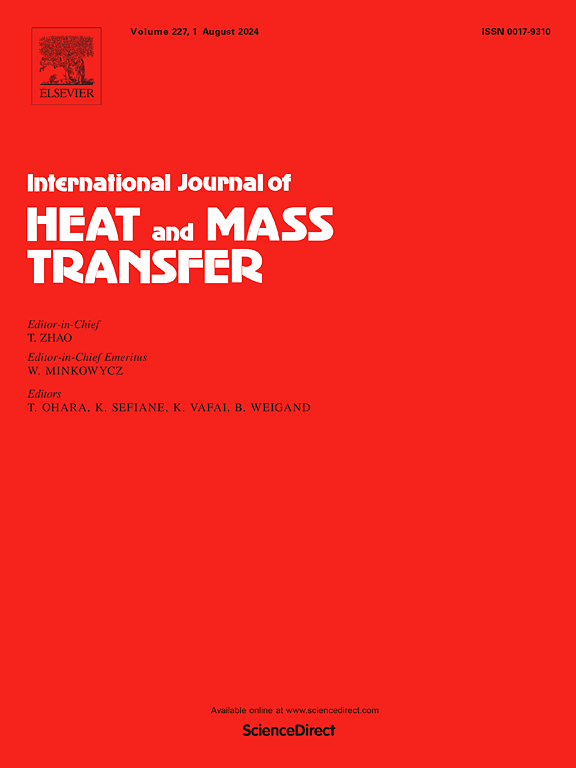Key factors affecting the boiling heat transfer coefficient of FC-72 in saturated pool boiling using lotus-type porous copper
IF 5.8
2区 工程技术
Q1 ENGINEERING, MECHANICAL
International Journal of Heat and Mass Transfer
Pub Date : 2024-11-29
DOI:10.1016/j.ijheatmasstransfer.2024.126477
引用次数: 0
Abstract
Boiling immersion cooling using dielectric liquids like FC-72 has shown promise for managing heat dissipation in semiconductor devices due to its low power consumption. However, the miniaturization and increasing operational currents of high-performance computer chips are driving heat fluxes towards 100 W/cm2, exceeding the critical heat flux (CHF) of saturated FC-72 at atmospheric pressure by approximately sevenfold. To address this challenge, this study proposes a lotus-type porous copper (lotus copper) with a unidirectional pore structure designed to induce a "breathing phenomenon" that facilitates efficient vapor removal. This approach achieved a CHF of 110 W/cm², surpassing the target value. Beyond CHF enhancement, this study also focuses on improving the heat transfer coefficient (HTC) to minimize device operating temperatures. Initially, the influence of grooved heat-transfer surface structures on HTC was investigated without lotus copper. Results indicated that incipient boiling predominantly occurred on the top surfaces of the grooves, highlighting the significance of top surface area in determining HTC. Based on this finding, two groove structures were selected to evaluate the effectiveness of lotus copper integration. Furthermore, the study demonstrates that the optimal pore size for maximizing HTC is dependent on the heat flux. Large-pore lotus copper excels at high heat fluxes due to its ability to efficiently expel vapor and maintain the breathing phenomenon. Conversely, small-pore lotus copper enhances HTC under low heat flux conditions by increasing bubble nucleation sites at the interface between the lotus copper and the groove surface.

莲花型多孔铜饱和池沸腾中影响FC-72沸腾换热系数的关键因素
使用像FC-72这样的介电液体进行沸腾浸没冷却,由于其低功耗,已经显示出在半导体器件中管理散热的希望。然而,高性能计算机芯片的小型化和不断增加的工作电流正在推动热流向100 W/cm2,超过饱和FC-72在大气压下的临界热流(CHF)约7倍。为了解决这一挑战,本研究提出了一种具有单向孔结构的莲花型多孔铜(莲花铜),旨在诱导“呼吸现象”,促进有效的蒸汽去除。该方法实现了110 W/cm²的CHF,超过了目标值。除了CHF增强之外,本研究还侧重于提高传热系数(HTC)以最小化设备工作温度。首先,在没有莲花铜的情况下,研究了沟槽传热表面结构对HTC的影响。结果表明,初沸主要发生在沟槽的上表面,突出了上表面面积对测定HTC的重要性。在此基础上,选择了两种凹槽结构来评价莲花铜集成的有效性。此外,研究表明,最大化HTC的最佳孔径取决于热通量。大孔莲花铜在高热通量方面表现出色,因为它能够有效地排出蒸汽并保持呼吸现象。相反,在低热流密度条件下,小孔莲花铜通过增加莲花铜与凹槽表面界面处的气泡成核位点来增强HTC。
本文章由计算机程序翻译,如有差异,请以英文原文为准。
求助全文
约1分钟内获得全文
求助全文
来源期刊
CiteScore
10.30
自引率
13.50%
发文量
1319
审稿时长
41 days
期刊介绍:
International Journal of Heat and Mass Transfer is the vehicle for the exchange of basic ideas in heat and mass transfer between research workers and engineers throughout the world. It focuses on both analytical and experimental research, with an emphasis on contributions which increase the basic understanding of transfer processes and their application to engineering problems.
Topics include:
-New methods of measuring and/or correlating transport-property data
-Energy engineering
-Environmental applications of heat and/or mass transfer

 求助内容:
求助内容: 应助结果提醒方式:
应助结果提醒方式:


